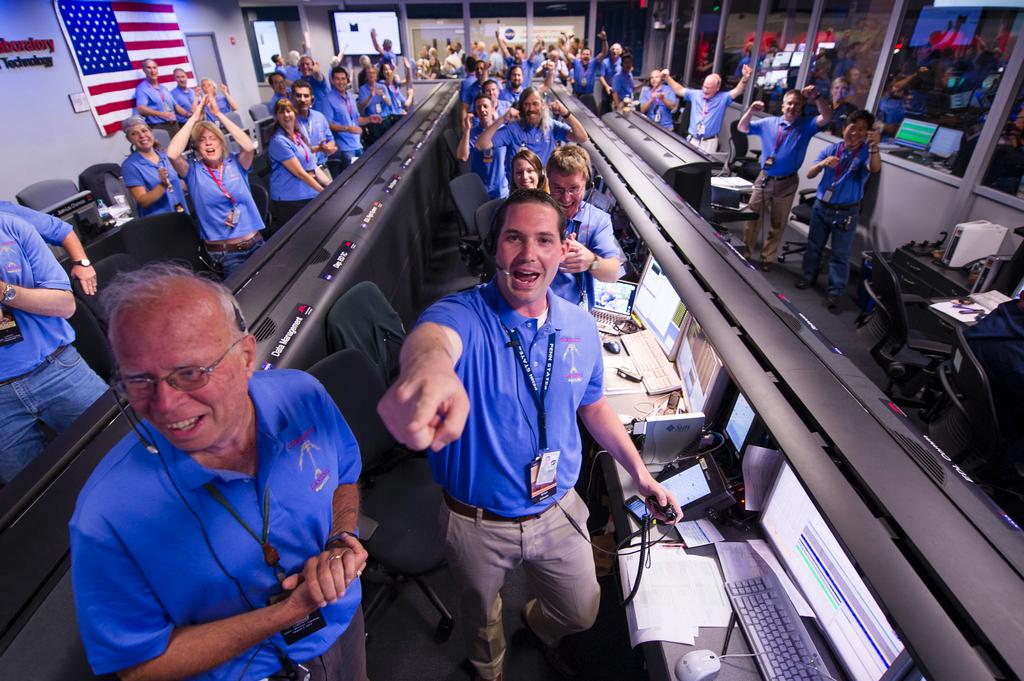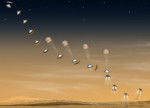“Oh Sh*t” is Heard Yelled After The 7 Minutes of Terror was Over! Curiosity Successfully Lands On Mars

One of the first images sent from Mars Rover Curiosity after landing notice the horizon and mountains in distance
Fifteen minutes of crying, screaming, handshaking, hugging and a big “Oh Sh*t” yelled out on UStream showing of the the successful landing of Curiosity.
Above are two of the first pictures taken by Curiosity after its perfect landing. where you can see the shadow of the rover in the picture and in one you can see a rover wheel and the Martian horizon.
Dr. Ravi Prakash Descent and Landing Engineer at NASA’s Jet Propulsion Lab (JPL) talks about this unprecedented landing and mission of a rover the size of a small car on Mars.
Landing Sunday August 5th
at 10pm Pacific Standard Time (PST)
Interview with Rocket Scientist Dr. Ravi Prakash on the landing and mission of the Curiosity Mars Science Lab / rover
Audio Player
►Right Click and “Save Link As” to Download File◄I would like to thank the JPL press office. I did not make the deadline to get press credentials, but they were so helpful at getting this interview together for me. They are Rocket Stars!
BTW in the interview I mentioned the landing would be Aug 6th.. Sorry it is August 5th at 10am PST. The correct time is 10pm on Sunday the 5th sorry for any confusion.
Also want to thank Dr Prakash. He is thrown into interview after interview and instead of rushing me through as many would, he worried if he had given enough. You did Dr. Prakash.. Thanks – JW
Dr Ravi Prakash
Texas born Dr. Ravi Prakash, who received a B.S. in aerospace engineering from the University of Texas at Austin and a M.S. in aerospace engineering from the Georgia Institute of Technology, joined NASA’s Jet Propulsion Laboratory (JPL) in 2005 and has been working at the Mars Science Laboratory ever since.
Dr. Ravi Prakash is a descent and landing engineer at JPL, working with his team to perfect an unprecedented unmanned landing on Mars, of the largest robotic rover ever sent into space.
[youtube=http://www.youtube.com/watch?v=P4boyXQuUIw]
MSL Landing
Follow Curiosity’s landing on Aug. 5, 2012 at 10:31 p.m. PDT (1:31 a.m. EDT, Aug. 6, 2012)!
Check Out This Excellent SlideShow [CLICK HERE]
The entry, descent, and landing (EDL) phase begins when the spacecraft reaches the Martian atmosphere, about 125 kilometers (about 78 miles) above the surface, and ends with the rover safe and sound on the surface of Mars.
Entry, descent, and landing for the Mars Science Laboratory mission will include a combination of technologies inherited from past NASA Mars missions, as well as exciting new technologies. Instead of the familiar airbag landing of the past Mars missions, Mars Science Laboratory will use a guided entry and a sky crane touchdown system to land the hyper-capable, massive rover.
The sheer size of the Mars Science Laboratory rover (900 kilograms or over 2,000 pounds) would preclude it from taking advantage of an airbag-assisted landing. Instead, the Mars Science Laboratory will use the sky crane touchdown system, which will be capable of delivering a much larger rover onto the surface. It will place the rover on its wheels, ready to begin its mission at Gale Crater.
The new entry, descent and landing architecture, with its use of guided entry, will allow for more precision. Where the Mars Exploration Rovers could have landed anywhere within their respective 150 by 20 kilometers (about 93 miles by 12 miles) landing ellipses, Mars Science Laboratory will land within a 20-kilometer (12-mile) ellipse! This high-precision delivery will open up more areas of Mars for exploration and potentially allow scientists to roam “virtually” where they have not been able to before. The entry, descent and landing sequence will break down into four parts:
- Guided Entry – The spacecraft will be controlled by small rockets during descent through the Martian atmosphere, toward the surface.
- Parachute Descent – Like Viking, Pathfinder and the Mars Exploration Rovers, the Mars Science Laboratory will be slowed by a large parachute.
- Powered Descent – Again, rockets will control the spacecraft’s descent until the rover separates from its final delivery system, the sky crane.
- Sky Crane – Like a large crane on Earth, the sky crane system will lower the rover to a “soft landing” – wheels down – on the surface of Mars.
 Curiosity’s Mission
Curiosity’s Mission
Mars Science Laboratory (MSL)
With its rover named Curiosity, Mars Science Laboratory mission is part of NASA’s Mars Exploration Program, a long-term effort of robotic exploration of the red planet. Curiosity was designed to assess whether Mars ever had an environment able to support small life forms called microbes. In other words, its mission is to determine the planet’s “habitability.”
Mars Science Laboratory will study Mars’ habitability
To find out, the rover will carry the biggest, most advanced suite of instruments for scientific studies ever sent to the martian surface. The rover will analyze samples scooped from the soil and drilled from rocks. The record of the planet’s climate and geology is essentially “written in the rocks and soil” — in their formation, structure, and chemical composition. The rover’s onboard laboratory will study rocks, soils, and the local geologic setting in order to detect chemical building blocks of life (e.g., forms of carbon) on Mars and will assess what the martian environment was like in the past.
Mars Science Laboratory relies on innovative technologies
Mars Science Laboratory will rely on new technological innovations, especially for landing. The spacecraft will descend on a parachute and then, during the final seconds prior to landing, lower the upright rover on a tether to the surface, much like a sky crane. Once on the surface, the rover will be able to roll over obstacles up to 75 centimeters (29 inches) high and travel up to 90 meters (295 feet) per hour. On average, the rover is expected to travel about 30 meters (98 feet) per hour, based on power levels, slippage, steepness of the terrain, visibility, and other variables.
The rover will carry a radioisotope power system that generates electricity from the heat of plutonium’s radioactive decay. This power source gives the mission an operating lifespan on Mars’ surface of a full martian year (687 Earth days) or more, while also providing significantly greater mobility and operational flexibility, enhanced science payload capability, and exploration of a much larger range of latitudes and altitudes than was possible on previous missions to Mars.
Arriving at Mars at 10:31 p.m. PDT on Aug. 5, 2012 (1:31 a.m. EDT on Aug. 6, 2012), Mars Science Laboratory will serve as an entrée to the next decade of Mars exploration. It represents a huge step in Mars surface science and exploration capability because it will:
- demonstrate the ability to land a very large, heavy rover to the surface of Mars (which could be used for a future Mars Sample Return mission that would collect rocks and soils and send them back to Earth for laboratory analysis)
- demonstrate the ability to land more precisely in a 20-kilometer (12.4-mile) landing circle
- demonstrate long-range mobility on the surface of the red planet (5-20 kilometers or about 3 to 12 miles) for the collection of more diverse samples and studies.
Visit MSL for Scientists for technical information about the mission
The Beautiful Video Game That Drives NASA’s Curiosity Mars Rover
So MSL Curiosity has landed. It survived the seven minutes of terror and safely touched down on the surface of Mars. A miracle in its own right. Now that it’s there, it needs a way to move around. Anyone who played Lunar Lander and Moon Patrol already knows how they’re going to do this: Video games.
Brian Cooper is the lead driver for MSL Curiosity, and he wrote the software to drive it. But that’s not all… READ MORE













































 Watch this Video on A Better Way To Fight Harmful Free Radicals
Watch this Video on A Better Way To Fight Harmful Free Radicals
